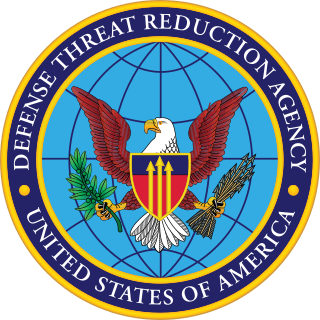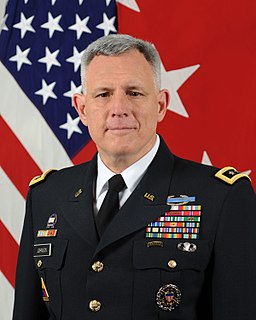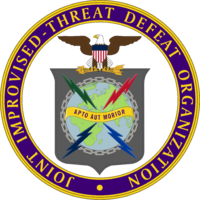
Bomb disposal is an explosives engineering profession using the process by which hazardous explosive devices are rendered safe. Bomb disposal is an all-encompassing term to describe the separate, but interrelated functions in the military fields of explosive ordnance disposal (EOD) and improvised explosive device disposal (IEDD), and the public safety roles of public safety bomb disposal (PSBD) and the bomb squad.

An improvised explosive device (IED) is a bomb constructed and deployed in ways other than in conventional military action. It may be constructed of conventional military explosives, such as an artillery shell, attached to a detonating mechanism. IEDs are commonly used as roadside bombs, or homemade bombs.

The Israeli Combat Engineering Corps is the combat engineering forces of the Israel Defense Forces.

The Defense Threat Reduction Agency (DTRA) is a combat support agency within the United States Department of Defense (DoD) for countering weapons of mass destruction. According to the agency's Strategic Plan for Fiscal Years 2018 to 2022, the DTRA mission "enables DoD and the U.S. Government to prepare for and combat weapons of mass destruction and improvised threats and to ensure nuclear deterrence." The agency is headquartered in Fort Belvoir, Virginia.

Montgomery Cunningham Meigs was a United States Army general. He was named for his great-great-great-granduncle, Quartermaster General Montgomery C. Meigs, the father of Arlington National Cemetery, and for his father Lieutenant Colonel Montgomery Meigs, a World War II tank commander who was killed in action one month before Meigs was born.

United States Navy Explosive Ordnance Disposal technicians render safe all types of ordnance, including improvised, chemical, biological, and nuclear. They perform land and underwater location, identification, render-safe, and recovery of foreign and domestic ordnance. They conduct demolition of hazardous munitions, pyrotechnics, and retrograde explosives using detonation and burning techniques. They forward deploy and fully integrate with the various Combatant Commanders, Special Operations Forces (SOF), and various warfare units within the Navy, Marine Corps, Air Force and Army. They are also called upon to support military and civilian law enforcement agencies, as well as the Secret Service.

Thomas Fredric Metz is a retired lieutenant general in the United States Army. Metz retired from the Army in Jan 2010 after more than 40 years of active military service. His tour of duty prior to retirement was as the director, Joint Improvised Explosive Device Defeat Organization., leading the DOD organization tasked with finding and fielding ways to defeat the IED threat. Previously he was the deputy commanding general and chief of staff, U.S. Army Training and Doctrine Command. Previous to that assignment he was commanding general of the U.S. III Corps and Fort Hood. He assumed command of III Corps on 7 February 2003.

Naval Surface Warfare Center Crane Division is the principal tenant command located at Naval Support Activity Crane. NSA Crane is a United States Navy installation located approximately 35 miles (56 km) southwest of Bloomington, Indiana, and predominantly located in Martin County, but small parts also extend into Greene and Lawrence counties. It was originally established in 1941 under the Bureau of Ordnance as the Naval Ammunition Depot for production, testing, and storage of ordnance under the first supplemental Defense Appropriation Act. The base is named after William M. Crane. The base is the third largest naval installation in the world by geographic area and employs approximately 3,300 people. The closest community is the small town of Crane, which lies adjacent to the northwest corner of the facility.

The 20th CBRNE Command is the United States Army's Chemical, Biological, Nuclear, Radiological and high-yield explosives headquarters.
In United States military doctrine, unconventional warfare is one of the core activities of irregular warfare. Unconventional warfare is essentially support provided by the military to a foreign insurgency or resistance. The legal definition of UW is:
Unconventional Warfare consists of activities conducted to enable a resistance movement or insurgency to coerce, disrupt or overthrow an occupying power or government by operating through or with an underground, auxiliary or guerrilla force in a denied area.

Maxie L. McFarland, was one of thirteen tier-3 US Government Defense Senior Executives, serving as the Deputy Chief of Staff for Intelligence (G–2) for the U.S. Army's Training and Doctrine Command located at Fort Monroe, Virginia. Starting in June 2011, he worked as the Executive Vice President for Strategic Planning for the Sierra Nevada Corporation. Maxie McFarland died on 8 November 2013 and is buried at Arlington National Cemetery. He was inducted into the Military Intelligence Hall of Fame in 2014.

Joseph Leonard Votel is a retired four-star general in the United States Army who was commander of United States Central Command from March 2016 to March 2019. Before that, he served as commander of the United States Special Operations Command.

Robert Bruce Abrams is a retired four-star general in the United States Army who last served as the commander of United States Forces Korea. He concurrently served as the commander of United Nations Command and commander of R.O.K.-U.S. Combined Forces Command. He previously served as the 22nd commanding general of United States Army Forces Command from August 10, 2015 to October 17, 2018. He is a 1982 graduate of the United States Military Academy where he was commissioned as an armor officer. During his years of active service, he has held command and staff positions across the Army and joint community in Germany, the United States, Southwest Asia and South Korea. Abrams comes from a family of career military officers. His father was former Army Chief of Staff General Creighton W. Abrams Jr., and both of his elder brothers, Creighton and John, were Army general officers.

The THOR III is man-portable, counter-radio-controlled improvised explosive device (IED) jammer built by Sierra Nevada Corp and employed by the U.S. Army, U.S. Marine Corps, and partnered Afghan National Army soldiers in Afghanistan. Sierra Nevada received the initial contract in December 2007. This system uses three transceivers mounted on backpacks to jam radio-controlled IEDs; each of the three different transceivers jams a different frequency bandwidth.

Michael Douglas Barbero is a retired United States Army Lieutenant General.

John D. Johnson is a retired American lieutenant general of the United States Army. He was director of the Joint Improvised Explosive Device Defeat Organization from July 2013 to July 2015.

Counter-IED efforts are done primarily by military and law enforcement with the assistance of the diplomatic and financial communities. It involves a comprehensive approach of countering the threat networks that employ improvised explosive devices (IEDs), defeating the devices themselves, and training others. Counter-IED, or C-IED, is usually part of a broader counter-terrorism, counter-insurgency, or law enforcement effort. Because IEDs are a subset of a number of forms of asymmetric warfare used by insurgents and terrorists, C-IED activities are principally against adversaries and not only against IEDs. C-IED treats the IED as a systemic problem and aims to defeat the IED threat networks themselves.

Counter-IED equipment are created primarily for military and law enforcement. They are used for standoff detection of explosives and explosive precursor components and defeating the Improvised Explosive Devices (IEDs) devices themselves as part of a broader counter-terrorism, counter-insurgency, or law enforcement effort.
Combined Joint Task Force Paladin was the International Security Assistance Force command responsible for counter-IED efforts and Explosive Ordnance Disposal (EOD) during the War in Afghanistan (2001–2021). With military and civilian personnel spread across the entire country, CJTF Paladin provided EOD Technicians, counter-IED trainers, intelligence personnel, and forensics labs to the ISAF Regional Commands.
The Rhino Passive Infrared Defeat System was an early detonation Counter-IED system. It was mounted to the front of a vehicle and used heat to prematurely detonate any hidden improvised explosive devices (IEDs) while the vehicle was at a safe distance away from the blast. It was developed by the Joint Improvised-Threat Defeat Organization (JIEDDO) in 2006 during the war in Iraq to counter the rise of IED-related deaths.
















